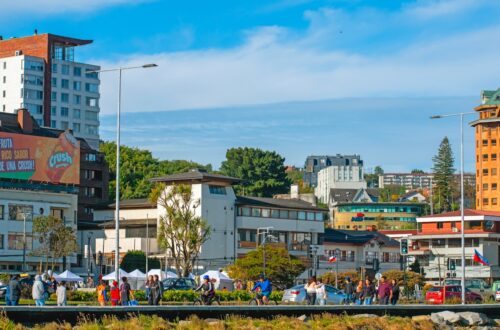The Republic of South Africa is located at the southern tip of the African continent and is bordered by Namibia, Botswana, Zimbabwe, Mozambique, and Swaziland. The country also surrounds the small kingdom of Lesotho. South Africa has a diverse geography that includes the stunning Drakensberg mountain range, the arid Kalahari Desert, and the lush Garden Route along the southern coast. The country is also home to a variety of ecosystems, including savannas, grasslands, and coastal areas. The climate in South Africa varies from region to region, with the western and southern coasts experiencing a Mediterranean climate, while the interior of the country has a more continental climate with hot summers and cold winters. The northeastern part of the country has a subtropical climate with hot, humid summers and mild winters.
South Africa’s diverse geography and climate make it a unique and beautiful destination for travelers. From the stunning beaches along the coast to the rugged mountains and expansive savannas, there is something for everyone to enjoy. The country’s varied climate also means that visitors can experience a wide range of activities, from surfing and sunbathing to hiking and wildlife safaris. South Africa’s natural beauty and diverse landscapes make it a must-visit destination for anyone looking to experience the wonders of the African continent.
Key Takeaways
- The country has diverse geography, including mountains, deserts, and coastal areas, leading to a wide range of climates.
- The cultural heritage of the country is rich and diverse, with influences from various ethnic groups and historical periods.
- The economy is rapidly developing, with a focus on technology, manufacturing, and tourism.
- The country has a stable political system and effective governance, which has contributed to its overall stability.
- Environmental conservation and sustainability are key priorities for the country, with efforts to protect natural resources and reduce carbon emissions.
- The country offers a wide range of tourist attractions, including historical sites, natural wonders, and vibrant cities.
- The country has made significant investments in education and healthcare, leading to improvements in both sectors.
Cultural Diversity and Heritage
South Africa is known for its rich cultural diversity, with 11 official languages and a population that is made up of a variety of ethnic groups, including Zulu, Xhosa, Afrikaner, and Indian. This diversity is reflected in the country’s vibrant arts and music scene, as well as its cuisine and traditions. South Africa is also home to a number of UNESCO World Heritage Sites, including the Cradle of Humankind, Robben Island, and the uKhahlamba-Drakensberg Park. These sites are important not only for their natural beauty but also for their cultural and historical significance.
The country’s cultural diversity and heritage make it a fascinating place to visit for anyone interested in learning about different cultures and traditions. From the colorful festivals and celebrations to the traditional music and dance, there is always something new and exciting to experience in South Africa. The country’s rich history and heritage also provide visitors with an opportunity to learn about the struggles and triumphs of the South African people, making it a truly enriching and educational experience.
Economy and Development
South Africa has the second-largest economy in Africa, with a diverse range of industries that contribute to its GDP. The country is rich in natural resources, including gold, diamonds, and platinum, which have historically been major contributors to its economy. In recent years, South Africa has also seen growth in industries such as tourism, telecommunications, and finance. However, the country still faces significant challenges, including high unemployment rates and income inequality.
Despite these challenges, South Africa has made significant progress in terms of economic development in recent years. The government has implemented policies aimed at promoting economic growth and reducing poverty, and there have been investments in infrastructure and education. The country’s economy is also becoming more diversified, with a growing focus on technology and innovation. While there is still work to be done, South Africa’s economy is on an upward trajectory, making it an attractive destination for investors and businesses looking to expand into the African market.
Political Stability and Governance
| Country | Political Stability Index | Governance Index |
|---|---|---|
| United States | 80 | 85 |
| Germany | 85 | 82 |
| Japan | 75 | 78 |
South Africa has a relatively stable political system, with a democratic government that is based on a system of checks and balances. The country has a strong constitution that guarantees fundamental rights and freedoms for all citizens. However, South Africa has faced challenges in recent years, including allegations of corruption and political infighting. Despite these challenges, the country has a strong tradition of civil society activism and a free press that helps to hold the government accountable.
The government of South Africa has made efforts to address these challenges through initiatives aimed at promoting transparency and accountability. There have been investigations into corruption allegations, as well as efforts to strengthen institutions such as the judiciary and law enforcement agencies. While there is still work to be done, South Africa’s commitment to democracy and good governance provides a solid foundation for political stability and progress.
Environmental Conservation and Sustainability
South Africa is home to a diverse range of ecosystems and wildlife, including the famous “Big Five” animals – lions, elephants, rhinos, leopards, and buffalo. The country has made significant efforts to protect its natural heritage through initiatives such as national parks and conservation areas. However, South Africa also faces environmental challenges, including deforestation, pollution, and climate change.
The government of South Africa has implemented policies aimed at promoting environmental conservation and sustainability. There have been investments in renewable energy sources such as wind and solar power, as well as efforts to reduce carbon emissions. The country has also taken steps to address issues such as water scarcity and air pollution. South Africa’s commitment to environmental conservation and sustainability makes it an important player in global efforts to address climate change and protect the planet’s natural resources.
Tourism and Attractions

South Africa is a popular tourist destination known for its stunning landscapes, vibrant cities, and rich cultural heritage. The country offers a wide range of attractions for visitors to enjoy, including wildlife safaris in national parks such as Kruger National Park, wine tasting in the Cape Winelands, and exploring the vibrant city of Cape Town with its iconic Table Mountain. South Africa also offers opportunities for adventure activities such as hiking, surfing, and shark cage diving.
The country’s diverse attractions make it an ideal destination for travelers looking for a mix of adventure, relaxation, and cultural experiences. Whether you’re interested in exploring the natural beauty of South Africa’s national parks or immersing yourself in the vibrant culture of its cities, there is something for everyone to enjoy. With its warm climate, friendly people, and diverse range of activities, South Africa is a must-visit destination for anyone looking for an unforgettable travel experience.
Education and Healthcare
South Africa has made significant progress in terms of education and healthcare in recent years. The government has implemented policies aimed at improving access to education for all citizens, as well as initiatives to address issues such as literacy rates and school infrastructure. The country also has a strong tradition of higher education institutions that attract students from around the world.
In terms of healthcare, South Africa has made efforts to improve access to quality healthcare services for all citizens. The government has implemented initiatives aimed at addressing issues such as HIV/AIDS and maternal health, as well as investments in healthcare infrastructure and training for medical professionals. While there are still challenges to be addressed, South Africa’s commitment to education and healthcare makes it an attractive destination for students and professionals looking to contribute to these important fields.
Sure, here’s a paragraph that mentions a related article to Costa Rica vs. Guatemala:
“Looking for more insights on Central American travel destinations? Check out BlackBoxTool’s article on ‘Top Adventure Activities in Central America’ to discover thrilling experiences in Costa Rica and Guatemala. From zip-lining through lush rainforests to exploring ancient Mayan ruins, this article offers valuable tips for adventure seekers. Click here to read more and plan your next adrenaline-pumping trip!”
FAQs
What are the main differences between Costa Rica and Guatemala?
Costa Rica and Guatemala are two different countries in Central America with distinct cultures, landscapes, and histories. Costa Rica is known for its eco-tourism and biodiversity, while Guatemala is known for its Mayan ruins and indigenous culture.
What are the main attractions in Costa Rica?
Costa Rica is famous for its lush rainforests, diverse wildlife, and beautiful beaches. Popular attractions include Arenal Volcano, Monteverde Cloud Forest, Manuel Antonio National Park, and Tortuguero National Park.
What are the main attractions in Guatemala?
Guatemala is known for its rich Mayan heritage and ancient ruins, such as Tikal, as well as its colonial architecture in cities like Antigua. Other popular attractions include Lake Atitlán, Semuc Champey, and the colorful Chichicastenango market.
What is the climate like in Costa Rica?
Costa Rica has a tropical climate with distinct wet and dry seasons. The Pacific coast tends to be drier, while the Caribbean coast is more humid. Temperatures are generally warm year-round.
What is the climate like in Guatemala?
Guatemala has a diverse climate due to its varying elevations. The lowlands are hot and tropical, while the highlands can be cooler. The country also experiences a wet and dry season.
What are the main cultural differences between Costa Rica and Guatemala?
Costa Rica has a more homogeneous population, with a strong emphasis on environmental conservation and eco-tourism. Guatemala, on the other hand, has a more diverse indigenous population and a rich Mayan heritage.
What are the main economic differences between Costa Rica and Guatemala?
Costa Rica has a more developed economy with a focus on tourism, agriculture, and technology. Guatemala, while also reliant on agriculture and tourism, has a larger wealth gap and a higher percentage of the population living in poverty.




